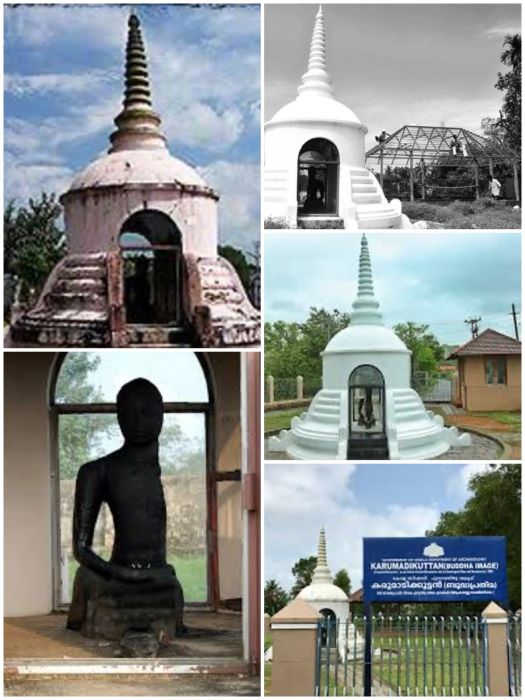The Karumadikuttan Buddha Statue: Historical and Cultural Significance
Ambalappuzha, Alappuzha District, Kerala
May 23rd, 2024
(SAMAJ WEEKLY)- The Karumadikuttan Buddha statue is a significant historical and cultural monument located in Karumady village, about 5 km from the Ambalappuzha Sree Krishna Swami Temple in Alappuzha district, Kerala. This ancient relic dates back to the 9th or 10th century and stands at a height of 3 feet, reflecting the influence of Buddhism in the region during that period. The statue, carved from black granite, serves as an important reminder of the presence and influence of Buddhism in Kerala, which thrived in the region during the early centuries before Hinduism regained prominence in the 10th–11th centuries. Discovered in the 1930s by Sir Robert Bristow, a British engineer, the Karumadikuttan Buddha statue has since become a protected monument. It is notable for being incomplete, with the left side of the statue missing, leading to various local legends and historical interpretations about its current state. The reasons for its partial destruction remain a subject of historical debate. However, the most widely accepted interpretation is that the statue was destroyed by Hindu kings who patronized Brahminism in the region, according to several scholars and literary sources. On May 5, 1965, the Dalai Lama visited Karumady and confirmed that the statue was erected to propagate Buddhism in Kerala. During his visit, the Dalai Lama contributed ₹6 lakh for the preservation of the statue, which was used to build the road leading to the Karumadikuttan statue.
The Role of Community Archaeology and Community Participation:
Community archaeology played a crucial role in preserving the Karumadikuttan Buddha statue. This approach to archaeological research and heritage management actively involves local communities in investigating and preserving their cultural heritage. This inclusive method fosters a sense of ownership and connection between communities and their past, enhancing the relevance and impact of archaeological work. Through the efforts of activists and the community around Karumady, the Department of Archaeology took steps to preserve this site. In 2014, the Department of Archaeology began renovating the statue of Lord Buddha at Karumady. According to G. Premkumar, director of the Department of Archaeology, the department was allotted ₹15 lakh for preliminary restoration works, including the construction of a compound wall, landscaping, installation of floor tiles, lighting, a security cabin, a resting place for visitors, and information counters.
Restoration Efforts and Challenges:
Rajeshkaran Pillai discovered a portion of the hand of the statue, and the district administration initially decided to reattach the hand. However, this move attracted protests from historians, leading to the abandonment of the plan. Historian M G S Narayanan had come out strongly against this, alleging violation of ASI’s principles of conservation. The portion of the hand was handed over to the Department of Archaeology, Kerala, and is currently kept at the department’s museum at Krishnapuram Palace in Kayamkulam.
Historical Connections and Cultural Legacy:
Karumadikuttan is also known as Sreemoolavasam, according to local belief and other sources. Sreemoolavasam was a famous Buddhist temple and center of pilgrimage on the southwestern coast of India. While the exact location of Sreemoolavasam remains unknown, it is believed to be in the northern parts of Kerala, with some sources suggesting it was located between Ambalappuzha and Thrikkunnappuzha in the Alappuzha district. This connection further evidences the nexus with Karumadikuttan.
Initially a Hinayana seat of learning, Sreemoolavasam gradually turned into a Mahayana center and later into a Hindu center. According to the inscription on the Paliyam copper plates, Sreemoolavasam, also known as Sreemoolavasam cheppedukal, dates back to AD 929 (or AD 898), issued by Ay king Vikramaditya Varagunan. The plates document significant land donations to the Sreemoolavasam, a Buddhist institution. Compiled in Tamil script (Tamil language with Vatteluttu script) and Nagari script (Sanskrit), the inscriptions are considered symbols of friendly relations between the Chera/Perumal rulers of Kerala and the institution.
The discovery of an idol of Bodhisattva Halahala Lokeswara in the Gandhara region, inscribed with “Dakshina Pathe Mulavasa Lokanatha,” proves that Sri Mulavasam was a famous Buddhist pilgrim center in ancient days. Local rulers are said to have protected this temple from encroachment by the Arabian Sea by strengthening the shore. The center perished after the 10th century, coinciding with the rise of the Chudamanivarma Vihara at Nagapattinam.
Preservation efforts from Buddhist Communities:
The Kerala Buddhist Council has taken a leading role in preserving the site, particularly with the help of Dhammasahayak and Dhammamitras. Regular Buddhist programs are organized to maintain the spiritual essence of the place, ensuring that the Karumadikuttan Buddha statue remains a vital part of Kerala’s cultural and historical heritage. Buddhist communities in Kerala do not merely view Buddhist heritage sites as historical artifacts but as sacred places imbued with spiritual significance. This spiritual connection motivates them to protect and maintain these sites as part of their religious duty. They see karumadikuttan heritage site as a repository of their cultural identity and history. By preserving these sites, they ensure the continuity of their cultural heritage across generations. The Buddhist organisations such as the Kerala Buddhist council through their regular Buddhist activities are often involved in regular maintenance such as cleaning the surroundings, and landscaping the surroundings to maintain the site’s integrity.
Gauthama Prabhu Nagappan
Independent Researcher,
Archaeological Justice and Maritime Buddhism









